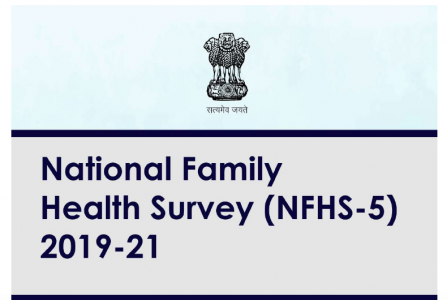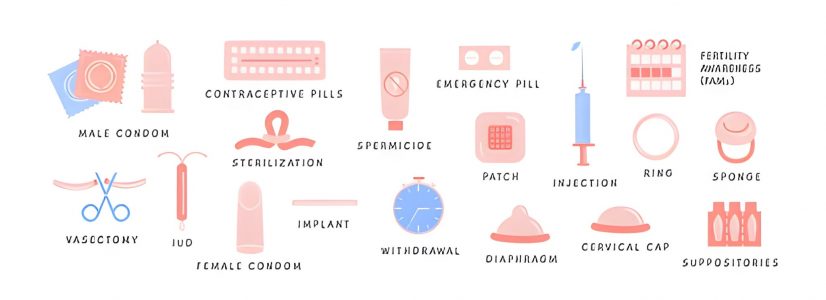Contraception in India: What Every Woman Should Know
When Priya told her husband she was considering sterilisation, his family resisted. They believed pregnancy should happen naturally, not by choice. But the truth is simple—pregnancy is a gift, not a mistake. Every woman deserves the right to plan her journey with confidence and care. Understanding contraception in India is central to that empowerment.
Despite progress, contraception in India is still often viewed as a woman’s burden. Cultural hesitation, family pressure, and limited awareness continue to shape how couples make decisions about reproductive health.

India’s contraceptive progress through NFHS-5 data
As a Senior Consultant Obstetrician and Gynaecologist at Fortis La Femme, I have witnessed how informed counselling and personalised contraceptive guidance transform lives. This article explores India’s evolving landscape of contraception—the data, available methods, and their effectiveness—so that every empowered woman can make safe, informed, and stigma-free choices for her body, health, and future.
Also Read:
- Natural Family Planning and Emergency Contraception Explained
- How Hormonal and Barrier Contraceptives Work
The Landscape of Contraception in India
India’s approach to family planning has evolved from population control to a rights-based model focused on informed choice. Yet, the country’s contraceptive landscape still shows wide regional and social variation.
Key Insights from NFHS-5
India’s progress in family planning tells an inspiring story of awareness and choice. More couples today are deciding when and how to grow their families, supported by better access to modern contraceptive methods.
 The latest NFHS-5 data shows this change clearly — the Contraceptive Prevalence Rate has increased to 67%. The unmet family planning needs have fallen to 9%. Even the need for spacing pregnancies is now below 10%. These numbers reflect a shift in mindset: women and couples are choosing informed, healthy, and confident control over their reproductive journey.
The latest NFHS-5 data shows this change clearly — the Contraceptive Prevalence Rate has increased to 67%. The unmet family planning needs have fallen to 9%. Even the need for spacing pregnancies is now below 10%. These numbers reflect a shift in mindset: women and couples are choosing informed, healthy, and confident control over their reproductive journey.
Comparing India’s Progress with Global Trends
When viewed in a global context, contraception in India reflects both progress and untapped potential. While India’s contraceptive prevalence rate now surpasses global targets, the journey toward diverse, equitable access continues.
The shift toward modern methods seen nationally is part of a wider global trend where women increasingly choose safe and reversible options. India now surpasses the global Sustainable Development Goal target for contraceptive prevalence but must ensure diversity of methods and equal access.
“Among 1.9 billion women of reproductive age (15–49 years), an estimated 874 million use a modern contraceptive method and 92 million a traditional method. The number of modern contraceptive users has nearly doubled worldwide since 1990.” — UN DESA, Population Division (2025)
Takeaway: India’s success is significant, but true empowerment requires moving beyond sterilisation toward balanced, informed, and inclusive family planning for all women.
Types of Contraception and Their Effectiveness
Each contraceptive method works differently and suits different health profiles, lifestyles, and reproductive goals. Understanding these options helps women choose safely and confidently.
1️⃣ Hormonal Contraception
Pills, patches, rings, and injectables such as Antara prevent ovulation and regulate menstrual cycles. The non-hormonal pill Chhaya offers an additional option. Hormonal methods are 91–94 percent effective when used correctly. They are reversible and help regulate periods but may cause mild, temporary side effects. Professional advice ensures safe use and correct dosage.
2️⃣ Barrier Methods
Male and female condoms, diaphragms, and cervical caps provide a physical barrier that prevents sperm from reaching the egg. They also protect against sexually transmitted infections. Their effectiveness ranges from 85 to 98 percent when used properly. Yet, condom use among married women in India is still only 9.5 percent, highlighting the need for greater male participation.

types of contraception
3️⃣ Long-Acting Reversible Contraceptives (LARCs)
Options such as Copper T, hormonal intrauterine devices, and subdermal implants offer 99 percent effectiveness. They provide three to ten years of protection, are fully reversible, and require minimal maintenance. The government now promotes these through public health programs to increase awareness and availability.
4️⃣ Natural Family Planning and Traditional Methods
Methods like rhythm tracking, basal body temperature, and withdrawal rely on understanding the menstrual cycle. Their effectiveness ranges between 76 and 88 percent and requires consistency and accurate tracking. In states such as Uttar Pradesh, traditional method use has risen from 1.3 percent in 1992 to nearly 18 percent in 2021—reflecting a mix of awareness and cultural comfort with non-medical options.
5️⃣ Permanent and Emergency Methods
Tubal ligation and vasectomy are safe, permanent procedures for couples certain about completing their families. Emergency contraception, available as pills or a Copper IUD, should be used within seventy-two hours of unprotected intercourse or method failure. Medical guidance is essential for correct use.
Takeaway: India offers a broad range of modern contraceptives, but short-term and reversible methods remain underused. Expanding male involvement and professional counselling can make contraception safer and more inclusive.
Choosing the Right Contraceptive — What to Discuss with Your Gynaecologist
Every woman’s body has its own rhythm and story. The best contraceptive choice respects both. Finding that balance begins with an honest conversation between you and your gynaecologist. Selecting a contraceptive method is a medical decision guided by personal health and future family goals.
Key Considerations
Before deciding, discuss the following with your gynaecologist:
- Medical history, including hypertension, diabetes, or PCOS
- Menstrual pattern and hormonal balance
- Reversibility needs and future pregnancy plans
- Lifestyle, work schedule, and comfort with routine use
Access and Affordability
India’s National Family Planning Program provides free or subsidised options through government hospitals and clinics. However, access remains uneven, especially in rural regions. Consulting a qualified gynaecologist helps women understand which methods suit their bodies best and prevents misuse or side effects.
Takeaway: Professional counselling is essential. The safest contraceptive is one chosen with medical guidance and tailored to your health and lifestyle.

Myths and Cultural Barriers
Cultural perceptions continue to shape how contraception is viewed and discussed in India. Many families still associate birth control with stigma or fear, preventing open dialogue. These myths not only create confusion but also delay timely medical guidance.
Common Myths and Facts
- Myth: Contraceptive pills cause infertility.
Fact: Fertility returns quickly after stopping pills; they do not cause long-term reproductive harm. - Myth: Intrauterine devices (IUDs) damage the uterus.
Fact: When inserted by trained professionals, IUDs are safe, reversible, and highly effective. - Myth: Contraception is only a woman’s duty.
Fact: Family planning works best when both partners share responsibility, including condom use and counselling participation. - Myth: Natural or traditional methods are the safest.
Fact: They have higher failure rates compared to medically approved modern methods. - Myth: Using contraception is against nature or morality.
Fact: Contraception protects health and choice, allowing couples to plan pregnancies responsibly.
Takeaway: Myths thrive where awareness is lacking. Reproductive health choices must be based on science, not stigma. Dispelling misconceptions through education empowers couples to make safe, informed, and shared decisions.
The Way Forward — Empowered and Informed Choices
Sustaining India’s progress requires awareness, accessibility, and active male participation. Every woman must have access to accurate information, safe options, and empathetic care.
Encouraging Male Involvement
Men must be part of the conversation. Promoting condom use, workplace awareness campaigns, and joint counselling sessions can normalise shared responsibility.
Strengthening Awareness and Access
Introducing contraceptive education in schools and expanding rural healthcare centres will help reach younger and underserved populations. Tele-consultations and community health workers can bridge the information gap in remote areas.
Doctor-Guided Empowerment
Gynaecologists play a pivotal role in counselling, addressing concerns, managing side effects, and guiding method transitions safely. Regular follow-ups ensure effectiveness and comfort for every woman.
Takeaway: Empowerment begins with knowledge. When contraception is approached through trust, access, and shared responsibility, it becomes a cornerstone of women’s health and equality.
Also Read:
- Festive Nights, Healthy Mornings: Sleep Care Tips for Women
- Contraceptive Counseling: Choosing the Right Method for You
- Common Myths and Misconceptions About Contraception: A Doctor’s Perspective
Conclusion
The journey of contraception in India reflects remarkable progress and evolving awareness. Modern contraceptive methods have become more accessible, yet challenges in diversity, counselling, and equality persist. True empowerment lies not only in preventing pregnancy but in giving women autonomy over their health and choices. From hormonal contraception to long-acting reversible options, today’s types of contraception offer flexibility, safety, and control. Continued family planning awareness and doctor-guided counselling will ensure every woman can make decisions best suited to her health and life goals.
Book your consultation with me to explore safe, effective contraception options tailored to your lifestyle, comfort, and reproductive wellbeing.
Our Digital Imprints:
Dr. Madhu Goel
Senior Consultant Obstetrician and Gynaecologist
Director, Fortis La Femme
I am passionate about women’s health. With expertise in managing high-risk pregnancies, infertility, and various gynaecological issues, I strive to provide compassionate care. I am committed to ensuring the well-being of my patients. Follow me for insights and updates on women’s health.
Get Connected to my Newsletter
“Health Hub”: Women’s Health & Wellness
Connect with me: Instagram | Facebook | LinkedIn





[…] Contraception in India: What Every Woman Should Know […]